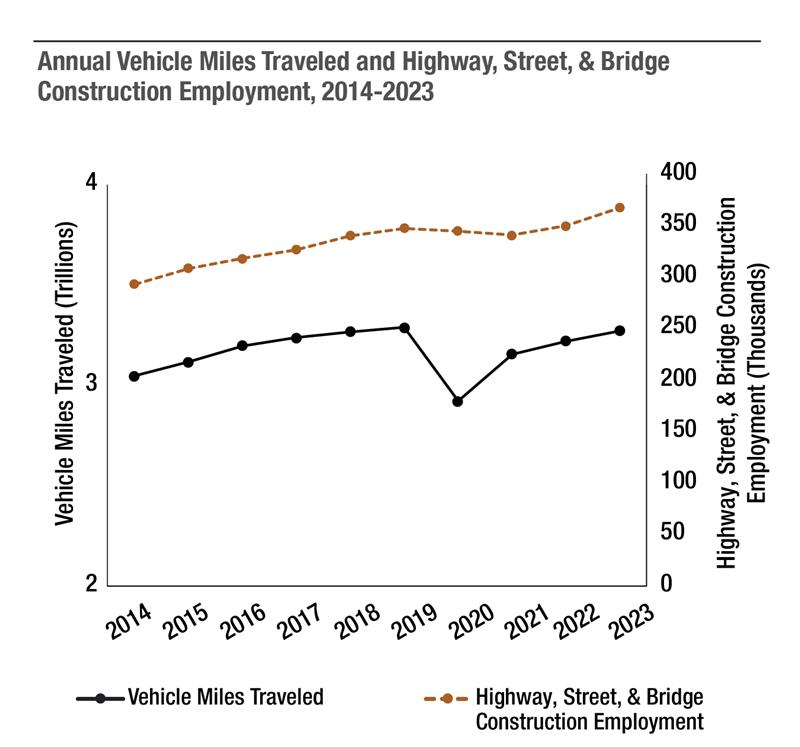Work Zone Data
Work Zone Data
Work Zone Traffic Crash Trends and Statistics
Data on fatal traffic crashes in work zones come from the Fatality Analysis Reporting Systems from the National Highway Traffic Safety Administration.1 These data represent crashes coded as occurring in a work zone from all 50 states, the District of Columbia, and Puerto Rico. These data are extracted from law enforcement crash report forms, and as such are only as accurate as the data included in those reports. Estimates of injuries occurring in work zones come from the NHTSA Crash Report Sampling System (CRSS) (2016-2023) and the General Estimates System (GES)(2014-2015).2 Data on annual vehicular travel in the U.S. comes from the Bureau of Transportation Statistics, U.S. Department of Transportation.3 Data regarding Highway, Street and Bridge Construction Employment in the U.S. comes from the Bureau of Labor Statistics, U.S. Department of Labor.4 These data represent national estimates of employment from all 50 states and the District of Columbia. As of July 2024, industry employment data is being used instead of inflation-adjusted Highway and Street Construction Expenditures. This is because the employment data provides a more natural benchmark for work zone exposure. Trends in the normalized spending data can also be highly sensitive to the choice of cost or price index.
Click on a graphic of interest below to get data details.
1 Fatality Analysis Reporting System. National Highway Traffic Safety Administration, U.S. Department of Transportation, Washington, D.C. Accessible at https://www.nhtsa.gov/research-data/fatality-analysis-reporting-system-fars. The 2014-2022 data were taken from the FARS final data files, while the 2023 data were from the 2023 Annual Report File (ARF). All data were downloaded in April 2025.
2 Crash Report Sampling System. National Highway Traffic Safety Administration, U.S. Department of Transportation, Washington, D.C. Accessible at https://www.nhtsa.gov/crash-data-systems/crash-report-sampling-system.
3 U.S. Vehicle Miles. Bureau of Transportation Statistics, U.S. Department of Transportation, Washington, D.C. Accessible at https://www.bts.gov/content/us-vehicle-miles.
4 Employment, Hours, and Earnings from the Current Employment Statistics survey (National). U.S. Department of Labor, Washington, D.C., Accessible at https://www.bls.gov/ces/data/.
![Work Zone Fatal Crashes and Percent of Fatal Crashes Occurring in Work Zones, 2014-2023 Over the past 10 years, fatal crashes in work zones have increased from 608 in 2014 to 818 in 2023, peaking in 2021 at 880. The percent of all fatal crashes that occur in work zones has also increased slightly, from 2.0 percent in 2014 to 2.2 percent in 2023. (Source: NHTSA FARS. The 2014-2022 data were taken from the FARS final data files, while the 2023 data were from the FARS 2023 Annual Report File [ARF]. All data were downloaded in April 2025.)](https://workzonesafety.org/wp-content/uploads/2025/07/2014-2023_fatal_crashes.jpg)
![Fatalities and Estimated Injuries Occurring in Work Zones, 2014-2023 Over the past 10 years, work zone fatalities have increased from 670 in 2014 to 899 in 2023. This equates to more than two persons per day being killed in work zones in 2023. Approximately four out of every five work zone fatalities involve a driver or passenger of a vehicle. Meanwhile, estimated injuries in work zones have also increased, from 31,000 in 2014 to 39,000 in 2023. In 2023, this equates to approximately 107 injuries per day in work zones. (Source: NHTSA FARS and CES/CRSS. The 2014-2022 fatality data were taken from the FARS final data files, while the 2023 fatality data were from the FARS 2023 Annual Report File [ARF]. The 2014-2105 estimated injury data were taken from the CES, while the 2016-2023 were from the CRSS. All data were downloaded in April 2025.)](https://workzonesafety.org/wp-content/uploads/2025/07/2014-2023_fatalities_est_injuries.jpg)

![Distribution of Fatal Work Zone and Non-Work Zone Crashes by Functional Classification and Land Use, 2021-2023 Average Compared to fatal non-work zone crashes, fatal work zone crashes are overrepresented on urban interstates, rural interstates, and rural principal arterials and freeways/expressways. (Source: NHTSA FARS. The 2021-2022 data were taken from the FARS final data files, while the 2023 data were from the FARS 2023 Annual Report File [ARF]. All data were downloaded in April 2025.)](https://workzonesafety.org/wp-content/uploads/2025/07/2021-2023_distribution_wz_crashes.jpg)
![Rear-End Collision Involvement in Fatal Work Zone and Non-Work Zone Crashes, 2021-2023 Average Rear-end collision involvement is consistently higher for fatal work zone crashes than for fatal non-work zone crashes for all roadways except urban collectors and local roads. The overrepresentation is most apparent on rural roadways. (Source: NHTSA FARS. The 2021-2022 data were taken from the FARS final data files, while the 2023 data were from the FARS 2023 Annual Report File [ARF]. All data were downloaded in April 2025.)](https://workzonesafety.org/wp-content/uploads/2025/07/2021-2023_rear-end_collision.jpg)
![Driver Distraction Involvement in Fatal Work Zone and Non-Work Zone Crashes, 2021-2023 Average Driver distraction contributes to fatal work zone crashes more often than to fatal non-work zone crashes. The overrepresentation is particularly evident on rural and urban interstates. (Source: NHTSA FARS. The 2021-2022 data were taken from the FARS final data files, while the 2023 data were from the FARS 2023 Annual Report File [ARF]. All data were downloaded in April 2025.)](https://workzonesafety.org/wp-content/uploads/2025/07/2021-2023_driver_distraction.jpg)
![Commercial Motor Vehicle Involvement in Fatal Work Zone and Non-Work Zone Crashes, 2021-2023 Average Commercial motor vehicles (large trucks and buses with a gross vehicle weight rating of more than 10,000 lbs) are highly overrepresented in fatal work zone crashes as compared to fatal non-work zone crashes. In fact, commercial motor vehicles are involved in almost 60 percent of fatal work zone crashes that occur on rural interstates. (Source: NHTSA FARS. The 2021-2022 data were taken from the FARS final data files, while the 2023 data were from the FARS 2023 Annual Report File [ARF]. All data were downloaded in April 2025.)](https://workzonesafety.org/wp-content/uploads/2025/07/2021-2023_commercial_vehicle.jpg)